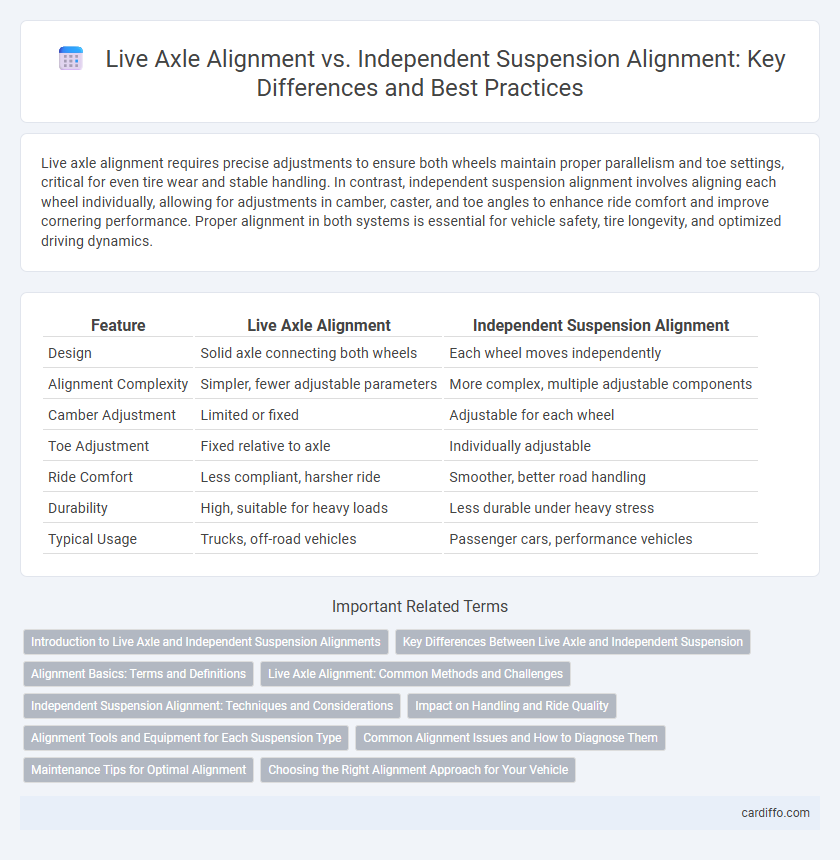Live axle alignment requires precise adjustments to ensure both wheels maintain proper parallelism and toe settings, critical for even tire wear and stable handling. In contrast, independent suspension alignment involves aligning each wheel individually, allowing for adjustments in camber, caster, and toe angles to enhance ride comfort and improve cornering performance. Proper alignment in both systems is essential for vehicle safety, tire longevity, and optimized driving dynamics.
Table of Comparison
| Feature | Live Axle Alignment | Independent Suspension Alignment |
|---|---|---|
| Design | Solid axle connecting both wheels | Each wheel moves independently |
| Alignment Complexity | Simpler, fewer adjustable parameters | More complex, multiple adjustable components |
| Camber Adjustment | Limited or fixed | Adjustable for each wheel |
| Toe Adjustment | Fixed relative to axle | Individually adjustable |
| Ride Comfort | Less compliant, harsher ride | Smoother, better road handling |
| Durability | High, suitable for heavy loads | Less durable under heavy stress |
| Typical Usage | Trucks, off-road vehicles | Passenger cars, performance vehicles |
Introduction to Live Axle and Independent Suspension Alignments
Live axle alignment involves adjusting the position of a solid rear axle that connects both wheels, ensuring proper camber, toe, and thrust angle for optimal tire wear and vehicle stability. Independent suspension alignment focuses on tuning each wheel's angles separately, allowing for better handling, improved ride comfort, and enhanced traction by accommodating individual wheel movement. Understanding the distinct alignment requirements of live axles and independent suspensions is crucial for achieving precise vehicle dynamics and safety.
Key Differences Between Live Axle and Independent Suspension
Live axle alignment involves adjusting a solid rear axle where both wheels are connected, resulting in limited independent wheel movement and simplified alignment settings focused on camber and toe angles. Independent suspension alignment allows each wheel to move independently, providing enhanced handling and ride quality, requiring precise adjustments of camber, caster, toe, and sometimes camber curve to optimize performance. Key differences include the live axle's rigidity causing less flexibility in alignment angles versus the independent suspension's complexity enabling better traction and reduced tire wear.
Alignment Basics: Terms and Definitions
Live axle alignment involves adjusting the solid rear axle to ensure proper camber, caster, and toe angles, crucial for maintaining vehicle stability and tire wear. Independent suspension alignment allows each wheel to be aligned separately, optimizing handling and ride comfort by precisely controlling wheel angles independently. Key alignment terms include camber (tilt of the wheel inward or outward), caster (steering axis tilt), and toe (direction wheels point relative to the centerline).
Live Axle Alignment: Common Methods and Challenges
Live axle alignment involves adjusting the axle's position and angle to ensure proper tracking and tire wear, often using methods such as toe, camber, and thrust angle adjustments. Common challenges include maintaining consistent alignment under heavy loads and compensating for limited adjustability compared to independent suspensions. Accurate live axle alignment helps optimize vehicle stability and prolong tire life despite these constraints.
Independent Suspension Alignment: Techniques and Considerations
Independent suspension alignment requires precise adjustments of camber, caster, and toe to optimize wheel angles for improved handling, ride comfort, and tire wear. Specialized alignment equipment and sensors are used to measure dynamic parameters accurately, accommodating the unique geometry of each wheel. Attention to suspension components like control arms and bushings is essential to maintain alignment stability and vehicle performance over time.
Impact on Handling and Ride Quality
Live axle alignment typically results in consistent wheel alignment under load, enhancing straight-line stability but often compromising ride comfort due to reduced wheel independence. Independent suspension alignment allows each wheel to move separately, improving handling responsiveness and ride quality by adapting better to road irregularities. Vehicles with independent suspension generally offer superior cornering performance and a smoother ride compared to those with live axles.
Alignment Tools and Equipment for Each Suspension Type
Live axle alignment requires heavy-duty alignment tools such as camber gauges, toe plates, and turn plates designed to handle the rigid axle's movement and constraints. Independent suspension alignment utilizes more advanced, precise equipment including laser alignment systems and computer-aided measuring devices to adjust multiple suspension arms and joints individually. Proper alignment tools for each suspension type ensure accurate adjustments, maximizing tire life and vehicle handling performance.
Common Alignment Issues and How to Diagnose Them
Common alignment issues in live axle setups include uneven tire wear, pulling to one side, and steering wheel misalignment, often caused by bent axles or worn bushings. Independent suspension alignment problems typically involve camber and caster irregularities, which result in instability, poor handling, and irregular tire tread patterns. Diagnosing these issues requires precise measurement of toe, camber, and caster angles using alignment machines and visual inspection for damaged suspension components.
Maintenance Tips for Optimal Alignment
Live axle alignment requires regular inspection of toe and camber angles to prevent uneven tire wear and maintain vehicle stability, emphasizing checks after heavy loads or rough terrain usage. Independent suspension alignment demands precise adjustment of caster, camber, and toe for each wheel, with frequent alignment checks recommended due to increased sensitivity to road conditions. Consistent use of quality alignment tools and adherence to manufacturer specifications ensure optimal alignment and extend suspension component lifespan.
Choosing the Right Alignment Approach for Your Vehicle
Choosing the right alignment approach depends on your vehicle's suspension type: live axle or independent suspension. Live axle alignment typically involves adjusting camber, caster, and toe on a solid rear axle, while independent suspension alignment requires precise calibration of each wheel individually due to its independent movement. Understanding your vehicle's suspension system ensures optimal handling, tire wear, and safety by selecting either a live axle or independent suspension alignment method.
Live Axle Alignment vs Independent Suspension Alignment Infographic

 cardiffo.com
cardiffo.com